Extraction of Impermeable Surfaces Based on Multi-Source Nighttime Light Images of Different Geomorphological Partitions
Abstract
1. Introduction
- The operational line system (OLS) sensor was launched in 1976 via the DMSP satellite. It is an oscillating scanning radiometer with a strip width of about 3000 km, consisting of two broad spectral bands [20]. It has a spatial resolution of 30 arc seconds [21]. As the DMSP-OLS nighttime light imagery is not perturbed by light shadows, it can be used for characterizing human activities, and is a good data source for dynamic monitoring of urban land expansion at large urbanization scales [22].
- The Suomi national polar partnership (NPP) satellite launched in October 2011 has an on-board visible infrared imaging radiometer suite (VIIRS) instrument, which is a 22-band visible/infrared sensor. It has the same strip width as the DMSP, i.e., 3000 km, but a higher spatial resolution of 15 arc seconds [23]. The VIIRS has fuller in-flight calibration, lower detection limits, wider dynamic range, and finer radiometric quantification. Furthermore, it can provide richer information about human habitation and economic activity compared to the OLS [24].
- As the first dedicated nighttime light satellite, Luojia1-01 has a spatial resolution of 130 m [25], a high radiance quantification of 15 bits, and a wide image frame of 250 km [26]. It provides a new nighttime light dataset with a high resolution and accuracy for artificial nighttime light variation monitoring [27]. It is seminal for the development and application of nocturnal remote sensing [28]. Since Luojia1-01 data do not suffer from saturation and bloom problems [29], Li et al. [30] found that the use of these data resulted in better impermeable surface extraction compared to using the NPP-VIIRS data.
- The existing high-resolution nighttime light data are mainly photographs taken by astronauts on the international space station (ISS) and commercial satellites, such as EROS-B and JL1-3 [31]. The data obtained from the ISS have a spatial resolution between 5 to 200 m, while those obtained from the commercial satellites have a resolution of less than 1 m [32]. This category of data has the advantage of fine resolution and multISDectral information. However, their high price and difficult acquisition have lowered the interest in their usage for impermeable surface extraction and urban land expansion.
- Derived datasets for nighttime lighting: Chen et al. produced a global “NPP-VIIRS-like” nighttime light dataset having a spatial resolution of 500 m with cross-sensor correction. These nighttime light data can effectively mitigate the oversaturation and overflow effects of the original DMSP-OLS data and use both types of data continuously over a time span [33]. Flint, developed by the Chinese Academy of Sciences Remote Sensing Satellite Ground Station, is the world’s first full sequence global nighttime light annual product based on the NPP-VIIRS sensor’s monthly nighttime light product. It has a 500 m resolution in its official version and a 1500 m resolution in its beta4 version. The Flint nighttime light images smooth out disturbances other than the surface factors and provide higher accuracy, stability, and ease of use to continuously track human activities on the Earth’s surface [34]. However, the derived datasets have not been widely used in various fields.
- (1)
- Threshold segmentation methods that include: the ① Empirical threshold method, which is the extraction of urban areas by artificially setting specific thresholds based on the validation of previous studies [35]; ② Mutation detection method proposed by Imhoff et al. [36], which is based on the assumption that urban impervious surfaces consist of intact patches, and, by gradually increasing the segmentation nighttime lighting threshold, the obtained polygonal patches represent the urban areas along the edges. When the segmentation threshold reaches a point where a polygonal patch breaks up from within, the perimeter of the polygon representing the urban area suddenly increases. Pixels with values greater than or equal to this threshold are considered part of the impervious surface area.
- (2)
- Data comparison methods that include: the ① Statistical Comparison Method, which uses the impervious surface area statistics released by the government as a reference and compares the difference between the extracted impervious surface area and the statistics. A threshold is generated iteratively until the extracted urban area matches the statistics [37]. ② Spatial comparison method, which uses high resolution multISDectral remote sensing data or land use data as auxiliary data to achieve urban impervious surface information extraction [38].
- (1)
- The scale and values of lights can become inconsistent with actual conditions due to cloud diffraction, moonlight, etc. [39]. This error may be amplified in topographically fragmented areas, and it becomes impossible to accurately represent the urban morphology of a region [40]. Consequently, there has been considerable discussion on the utility of nighttime light imagery in topographically fragmented areas for truly representing the urban form of complex landscapes.
- (2)
- Topographic conditions strongly influence the spatial distribution of nighttime lights and human activities. The spatial correlation between nighttime light images and surface types at fine scales [41] is essential for the application of nighttime light images for impermeable surface extraction. However, because of the late start of research on nighttime remote sensing data in China (a study of population change in important cities in mainland China based on nighttime light data), there are only a few studies on Karst mountains, and the existing empirical studies mainly analyze their relationships with various social environments. Meanwhile, in practical applications, “remote and inaccessible areas” are not perfectly distributed within a specific administrative area. From a geographical perspective, economic and social development emphasizes the process and state of achieving or failing to achieve coordinated development of “people”, “industry”, and “land” in a specific spatial and temporal context [42]. The socio-economic situation of any region has its own specific geographical background. The study of the application of nighttime light images should emphasize its usage in a regional context and not remain limited to a specific administrative area. It should provide the theory and applications that can be applied to different regions in similar natural environment backgrounds.
- (1)
- Luojia1-01 nighttime light data, which do not have saturation and blooming issues;
- (2)
- NPP-VIIRS nighttime light data, which are the most widely used in current research; and
- (3)
- “Flint” nighttime light data, which can smooth out disturbances other than surface factors.
2. Materials and Methods
2.1. Overview of the Study Area
2.2. Data Preprocessing
2.2.1. Luojia1-01
2.2.2. NPP-VIIRS
2.2.3. Flint
2.2.4. Unified Scale
2.2.5. Other Data
2.3. Research Methodology
2.3.1. Impermeable Surface Extraction
- (1)
- The ROI module of ENVI is used to extract queue values for light segmentation.
- (2)
- The polygonal patches representing the urban areas are gradually reduced along the edges while the segmentation nighttime light threshold is gradually increased.
- (3)
- When the segmentation threshold reaches a certain point, the polygon patch breaks up from inside and its perimeter representing the urban area suddenly increases. This is the threshold point for extracting the impermeable surface area. The pixels whose values are greater than or equal to the threshold are considered as part of the impermeable surface area.
2.3.2. Accuracy Verification
3. Results
3.1. Impermeable Surface Extraction
3.1.1. Impervious Surface Extraction Results
3.1.2. Impermeable Surface Density Extraction Results
3.2. Impermeable Surface Accuracy Verification
3.2.1. Spatial Accuracy of Impervious Surfaces
3.2.2. Impervious Surface Area Error
4. Discussion and Conclusions
4.1. Discussion
4.1.1. Accuracy Analysis
4.1.2. Error Analysis and Insights
- (i)
- Climatic conditions in the Karst mountains themselves. The cloudy and rainy climatic characteristics of the Karst mountains can easily bias the collected light data due to factors such as cloud cover, pollutants, and other light sources [44].
- (ii)
- Zone modelling approach. There are complex reasons that affect the construction of impermeable surfaces in reality, including topography, social, economic and ecological aspects, etc. More complex factors should be considered in actual modelling, and using only geomorphology as the standard zoning approach may not be suitable for different types of nighttime light data.
4.1.3. Comparison with Existing Studies
4.2. Conclusions
Author Contributions
Funding
Institutional Review Board Statement
Informed Consent Statement
Data Availability Statement
Conflicts of Interest
References
- Chowdhury, P.K.R.; Maithani, S. Monitoring growth of built-up areas in indo-gangetic plain using multi-sensor remote sensing data. J. Indian Soc. Remote Sens. 2010, 38, 291–300. [Google Scholar] [CrossRef]
- Chen, Y.B.; Zheng, Z.H.; Wu, C.F.; Qian, Q.L. A review and outlook on the application of remote sensing data for nighttime lighting. Adv. Geosci. 2019, 2, 205–223. [Google Scholar]
- Wang, Y.; Li, M. Urban Impervious Surface Detection from Remote Sensing Images: A review of the methods and challenges. IEEE Geosci. Remote Sens. Mag. 2019, 7, 64–93. [Google Scholar] [CrossRef]
- Yu, Y.; Li, J.; Zhu, C.; Plaza, A. Urban Impervious Surface Estimation from Remote Sensing and Social Data. Photogramm. Eng. Remote Sens. 2018, 84, 771–780. [Google Scholar] [CrossRef]
- Wang, H.; Lu, S.; Wu, B.; Li, X. Advances in remote sensing extraction of impermeable surfaces and applications. Adv. Earth Sci. 2013, 3, 327–336. [Google Scholar]
- Zhang, T.; Huang, X. Monitoring of urban impervious surfaces using time series of high-resolution remote sens-ing images in rapidly urbanized areas: A case study of Shenzhen. IEEE J. Sel. Top. Appl. Earth Obs. Remote Sens. 2018, 11, 2692–2708. [Google Scholar] [CrossRef]
- Wu, H. Quantitative Analysis of the Effect of Impervious Surface Coverage on Surface Temperature. Master’s Thesis, Xiangtan University, Xiangtan, China, 2021. Available online: https://kns.cnki.net/KCMS/detail/detail.aspx?dbname=CMFD202201&filename=1022451492.nh (accessed on 1 June 2021).
- Zhao, M.; Zhou, Y.; Li, X.; Cao, W.; He, C.; Yu, B.; Elvidge, C.D.; Cheng, W. Applications of Satellite Remote Sensing of Nighttime Light Observations: Advances, Challenges, and Perspectives. Remote Sens. 2019, 11, 1971. [Google Scholar] [CrossRef]
- Goodchild, M.F.; Quattrochi, D.A. Scale in Remote Sensing and GIS; Lewis Publishers: New York, NY, USA, 2023. [Google Scholar]
- Weng, Q. Remote sensing of impervious surfaces in the urban areas: Requirements, methods, and trends. Remote Sens. Environ. 2012, 117, 34–49. [Google Scholar] [CrossRef]
- Yuan, F.; Bauer, M.E. Comparison of impervious surface area and normalized difference vegetation index as indicators of surface urban heat island effects in Landsat imagery. Remote Sens. Environ. 2007, 106, 375–386. [Google Scholar] [CrossRef]
- Yang, L.; Huang, C.; Homer, C.G.; Wylie, B.K.; Coan, M.J. An approach for mapping large-scale impervious sur-faces: Synergistic use of Landsat-7 ETM+ and high spatial resolution imagery. Can. J. Remote Sens. 2003, 29, 230–240. [Google Scholar] [CrossRef]
- Schneider, A. Monitoring land cover change in urban and peri-urban areas using dense time stacks of Landsat satel-lite data and a data mining approach. Remote Sens. Environ. 2012, 124, 689–704. [Google Scholar] [CrossRef]
- Hu, T. Research on Multi-Layer Classification of Urban Land Cover and Structure Types Oriented to Landsat Remote Sensing Imagery. Ph.D. Thesis, Wuhan University, Wuhan, China, 2020. Available online: https://kns.cnki.net/KCMS/detail/detail.aspx?dbname=CDFDLAST2022&filename=1020967147.nh (accessed on 1 April 2020).
- Elvidge, C.D.; Tuttle, B.T.; Sutton, P.C.; Baugh, K.E.; Howard, A.T.; Milesi, C.; Bhaduri, B.L.; Nemani, R. Global Distribution and Density of Constructed Impervious Surfaces. Sensors 2007, 7, 1962–1979. [Google Scholar] [CrossRef] [PubMed]
- Liu, Z.; He, C.; Zhang, Q.; Huang, Q.; Yang, Y. Extracting the dynamics of urban expansion in China using DMSP-OLS nighttime light data from 1992 to 2008. Landsc. Urban Plan. 2012, 106, 62–72. [Google Scholar] [CrossRef]
- Xu, T.; Ma, T.; Zhou, C.; Zhou, Y. Characterizing Spatio-Temporal Dynamics of Urbanization in China Using Time Series of DMSP/OLS Night Light Data. Remote Sens. 2014, 6, 7708–7731. [Google Scholar] [CrossRef]
- Ao, Y.; Wu, B.-L.; Bai, Z.; Wang, X.-F.; Chen, Z.-X. Spatial and temporal dynamic characteristics of urban built-up areas in Guangdong-Hong Kong-Macao Greater Bay Area based on NPP-like VIIRS nighttime lighting data. J. Earth Sci. Environ. 2022, 44, 513–523. [Google Scholar] [CrossRef]
- Zheng, Q.; Deng, J.; Jiang, R.; Wang, K.; Xue, X.; Lin, Y.; Huang, Z.; Shen, Z.; Li, J.; Shahtahmassebi, A.R. Monitoring and assessing “ghost cities” in Northeast China from the view of nighttime light remote sensing data. Habitat Int. 2017, 70, 34–42. [Google Scholar] [CrossRef]
- Elvidge, C.D.; Imhoff, M.L.; Baugh, K.E.; Hobson, V.R.; Nelson, I.; Safran, J.; Dietz, J.B.; Tuttle, B.T. Night-time lights of the world: 1994–1995. ISPRS J. Photogramm. Remote Sens. 2001, 56, 81–99. [Google Scholar] [CrossRef]
- Elvidge, C.D.; Baugh, K.E.; Zhizhin, M.; Hsu, F.-C. Why VIIRS data are superior to DMSP for mapping nighttime lights. Proc. Asia-Pac. Adv. Netw. 2013, 35, 62. [Google Scholar] [CrossRef]
- Guo, W. Nocturnal Lighting Data and MODIS Data for Large-Scale Impervious Surface Mapping. Ph.D. Thesis, Wuhan University, Wuhan, China, 2015. [Google Scholar]
- Ding, J.; Leng, Z. A geographic analysis of regional poverty. J. Geogr. 2018, 73, 232–247. [Google Scholar]
- Gao, B.; Huang, Q.; He, C.; Ma, Q. Dynamics of Urbanization Levels in China from 1992 to 2012: Perspective from DMSP/OLS Nighttime Light Data. Remote Sens. 2015, 7, 1721–1735. [Google Scholar] [CrossRef]
- Liu, Q.; Zham, Q.; Li, J.; Yang, C.; Liu, W. Extracting Impermeable surfaces Using Luojia-1A Nighttime Light Im-ageries in Wuhan, China. Geomat. Inf. Sci. Wuhan Univ. 2021, 46, 30–39. [Google Scholar] [CrossRef]
- Zhang, C.; Pei, Y.; Li, J.; Qin, Q.; Yue, J. Application of Luojia1-01 Nighttime Images for Detecting the Light Changes for the 2019 Spring Festival in Western Cities, China. Remote Sens. 2020, 12, 1416. [Google Scholar] [CrossRef]
- Li, C.; Yang, W.; Tang, Q.; Tang, X.; Lei, J.; Wu, M.; Qiu, S. Detection of Multidimensional Poverty Using Luojia1-01 Nighttime Light Imagery. J. Indian Soc. Remote Sens. 2020, 48, 963–977. [Google Scholar] [CrossRef]
- Wang, X.; Zhou, T.; Tao, F.; Zang, F. Correlation Analysis between UBD and LST in Hefei, China, Using Luojia1-01 Night-Time Light Imagery. Appl. Sci. 2019, 9, 5224. [Google Scholar] [CrossRef]
- Li, X.; Zhao, L.; Han, W.; Faouzi, B.; Washaya, P.; Zhang, X.; Jin, H.; Wu, C. Evaluating Algeria’s social and economic development using a series of night-time light images between 1992 to 2012. Int. J. Remote Sens. 2018, 39, 9228–9248. [Google Scholar] [CrossRef]
- Li, X.; Zhou, W. Dasymetric mapping of urban population in China based on radiance corrected DMSP-OLS nighttime light and land cover data. Sci. Total Environ. 2018, 643, 1248–1256. [Google Scholar] [CrossRef]
- Pauwels, J.; Le Viol, I.; Azam, C.; Valet, N.; Julien, J.-F.; Bas, Y.; Lemarchand, C.; de Miguel, A.S.; Kerbiriou, C. Accounting for artificial light impact on bat activity for a biodiversity-friendly urban planning. Landsc. Urban Plan. 2018, 183, 12–25. [Google Scholar] [CrossRef]
- Hu, W.; Liu, C.; Zhan, Q. Synthesis method and comparative verification of annual nighttime light data of npp-viirs in China. J. Guilin Univ. Technol. 2021, 41, 8. [Google Scholar]
- Zhang, G.; Wang, J.; Jiang, Y.; Zhou, P.; Zhao, Y.; Xu, Y. On-Orbit Geometric Calibration and Validation of Luojia1-01 Night-Light Satellite. Remote Sens. 2019, 11, 264. [Google Scholar] [CrossRef]
- Sutton, P.; Roberts, D.; Elvidge, C.; Meij, H. A Comparison of Nighttime Satellite Imagery. Photogramm. Eng. Remote Sens. 1997, 63, 1303–1313. [Google Scholar]
- Imhoff, M.L.; Lawrence, W.T.; Stutzer, D.C.; Elvidge, C.D. A technique for using composite DMSP/OLS “city lights” sat-ellite data to map urban area. Remote Sens. Environ. 1997, 61, 361–370. [Google Scholar] [CrossRef]
- Miller, S.D.; Mills, S.P.; Elvidge, C.D.; Lindsey, D.T.; Lee, T.F.; Hawkins, J.D. Suomi satellite brings to light a unique frontier of nighttime environmental sensing capabilities. Proc. Natl. Acad. Sci. USA 2012, 109, 15706–15711. [Google Scholar] [CrossRef] [PubMed]
- Cao, Z.; Wu, Z.; Kuang, Y.; Huang, N. Correction and application of Dmsp/ols nighttime light imagery for the Chinese region. J. Geoinform. Sci. 2015, 17, 11. [Google Scholar]
- Vapnik, V.; Chapelle, O. Bounds on Error Expectation for Support Vector Machines. Neural Comput. 2000, 12, 2013–2036. [Google Scholar] [CrossRef] [PubMed]
- Mazzoni, D.; Horváth, Á.; Garay, M.J.; Tang, B.; Davies, R. A MISR Cloud-Type Classifier Using Reduced Support Vector Machines[C]//Eighth Workshop on Mining Scientific. 2005; Volume 19. Available online: https://ml.jpl.nasa.gov/papers/mazzoni/mazzoni-msd05-misr.pdf (accessed on 17 December 2022).
- Levin, N.; Kyba, C.C.; Zhang, Q.; de Miguel, A.S.; Román, M.O.; Li, X.; Portnov, B.A.; Molthan, A.L.; Jechow, A.; Miller, S.D.; et al. Remote sensing of night lights: A review and an outlook for the future. Remote Sens. Environ. 2019, 237, 111443. [Google Scholar] [CrossRef]
- Ma, T. An Estimate of the Pixel-Level Connection between Visible Infrared Imaging Radiometer Suite Day/Night Band (VIIRS DNB) Nighttime Lights and Land Features across China. Remote Sens. 2018, 10, 723. [Google Scholar] [CrossRef]
- Wang, Y.; Shen, Z. Comparing Luojia1-01 and VIIRS Nighttime Light Data in Detecting Urban Spatial Structure Using a Threshold-Based Kernel Density Estimation. Remote Sens. 2021, 13, 1574. [Google Scholar] [CrossRef]
- Guo, B.; Bian, Y.; Zhang, D.; Su, Y.; Wang, X.; Zhang, B.; Wang, Y.; Chen, Q.; Wu, Y.; Luo, P. Estimating Socio-Economic Parameters via Machine Learning Methods Using Luojia1-01 Nighttime Light Remotely Sensed Images at Multiple Scales of China in 2018. IEEE Access 2021, 9, 34352–34365. [Google Scholar] [CrossRef]
- Li, F.; Liu, X.; Liao, S.; Jia, P. The Modified Normalized Urban Area Composite Index: A Satelliate-Derived High-Resolution Index for Extracting Urban Areas. Remote Sens. 2021, 13, 2350. [Google Scholar] [CrossRef]
- Gong, P.; Li, X.; Wang, J.; Bai, Y.; Chen, B.; Hu, T.; Liu, X.; Xu, B.; Yang, J.; Zhang, W.; et al. Annual maps of global artificial impervious area (GAIA) between 1985 and 2018. Remote Sens. Environ. 2019, 236, 111510. [Google Scholar] [CrossRef]
- Xu, Z.; Gao, X. A novel method for identifying the boundary of urban Impermeable surfaces with POI data. Acta Geogr. Sin. 2016, 71, 928–939. [Google Scholar]
- Wu, S.P.; Zhou, Z.F.; Zhu, M.; Huang, D.H.; Peng, R.W. Spatial and temporal characteristics of drought in different landform types in a typical karst agglomeration. Soil Water Conserv. Res. 2023, 1, 336–347. [Google Scholar] [CrossRef]
- Ou, J.; Liu, X.; Liu, P.; Liu, X. Evaluation of Luojia1-01 nighttime light imagery for impervious surface detection: A comparison with NPP-VIIRS nighttime light data. Int. J. Appl. Earth Obs. Geoinf. 2019, 81, 1–12. [Google Scholar] [CrossRef]
- Tang, F.; Xu, H. Impervious Surface Information Extraction Based on Hyperspectral Remote Sensing Imagery. Remote Sens. 2017, 9, 550. [Google Scholar] [CrossRef]
- Kotarba, A.Z.; Aleksandrowicz, S. Impervious surface detection with nighttime photography from the International Space Station. Remote Sens. Environ. 2016, 176, 295–307. [Google Scholar] [CrossRef]
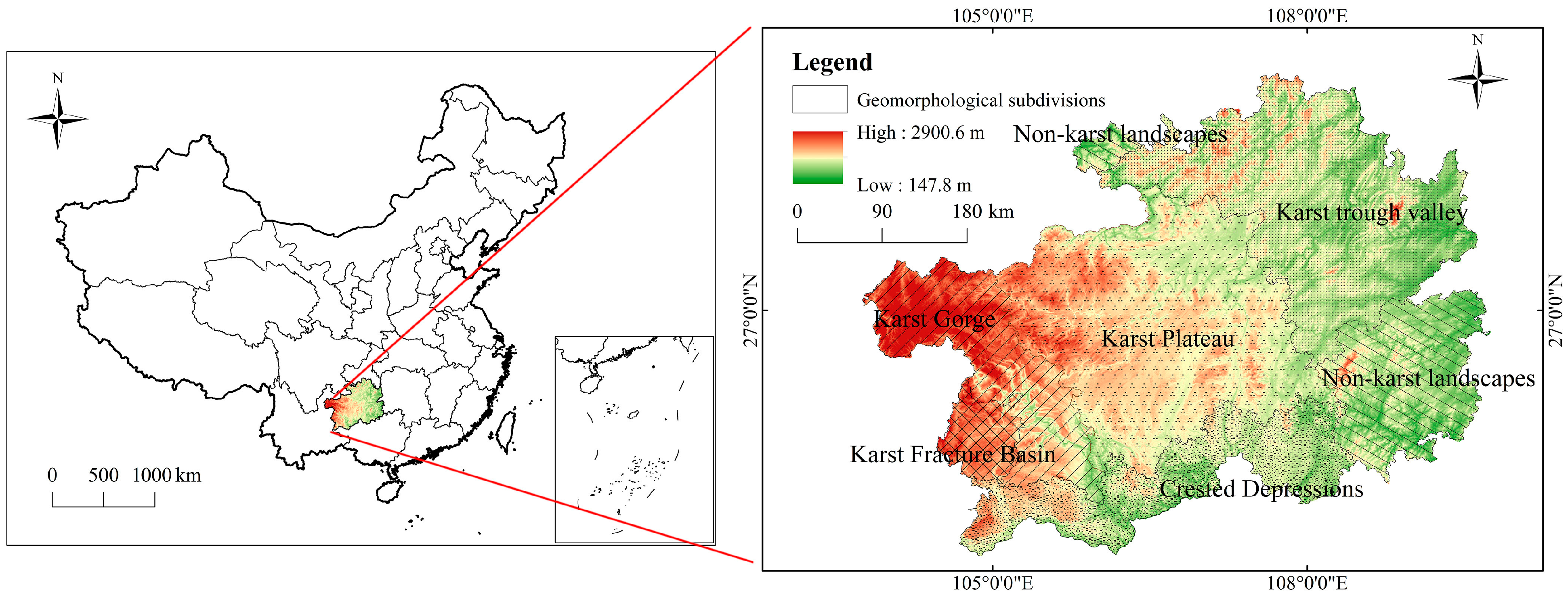
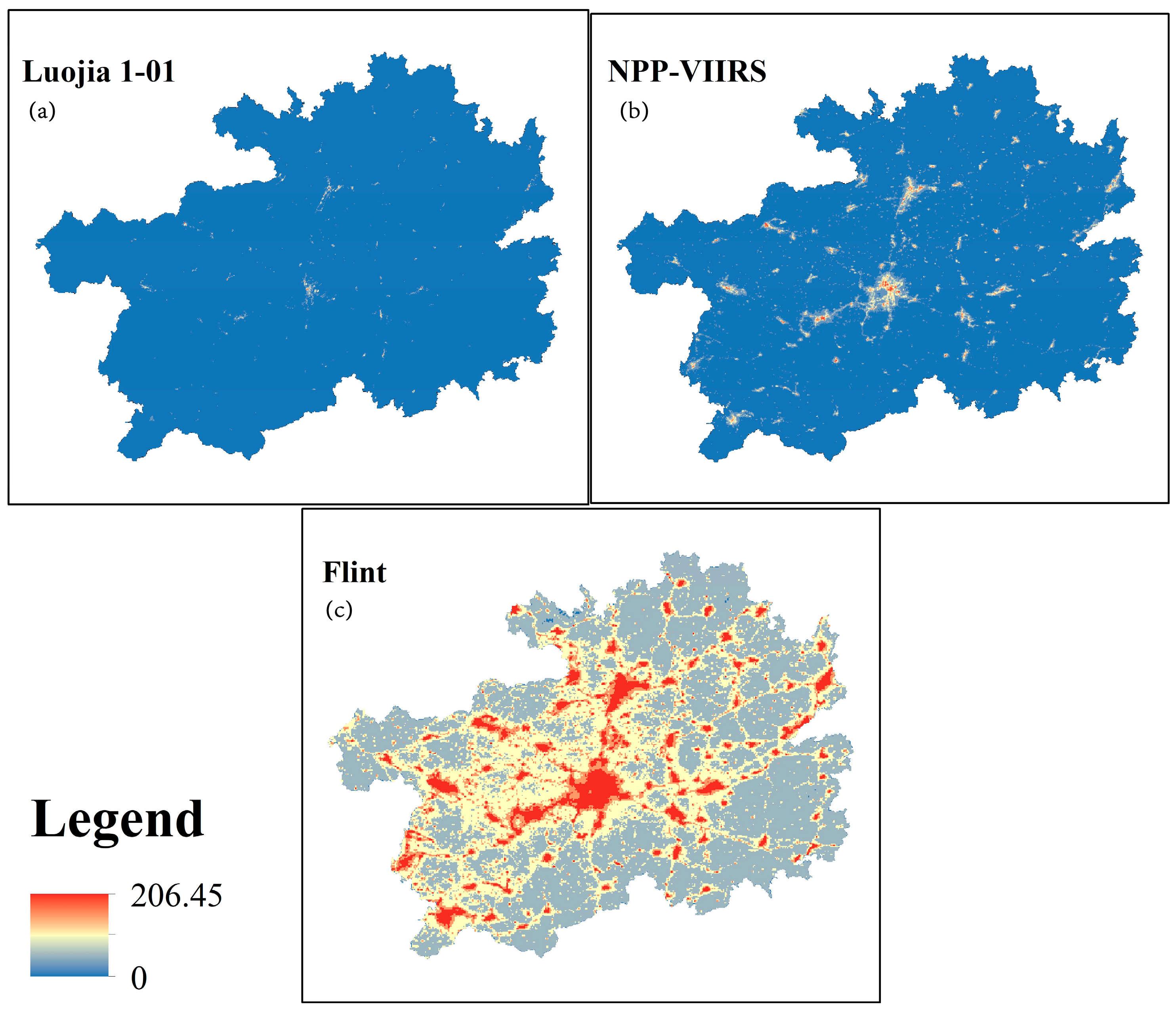
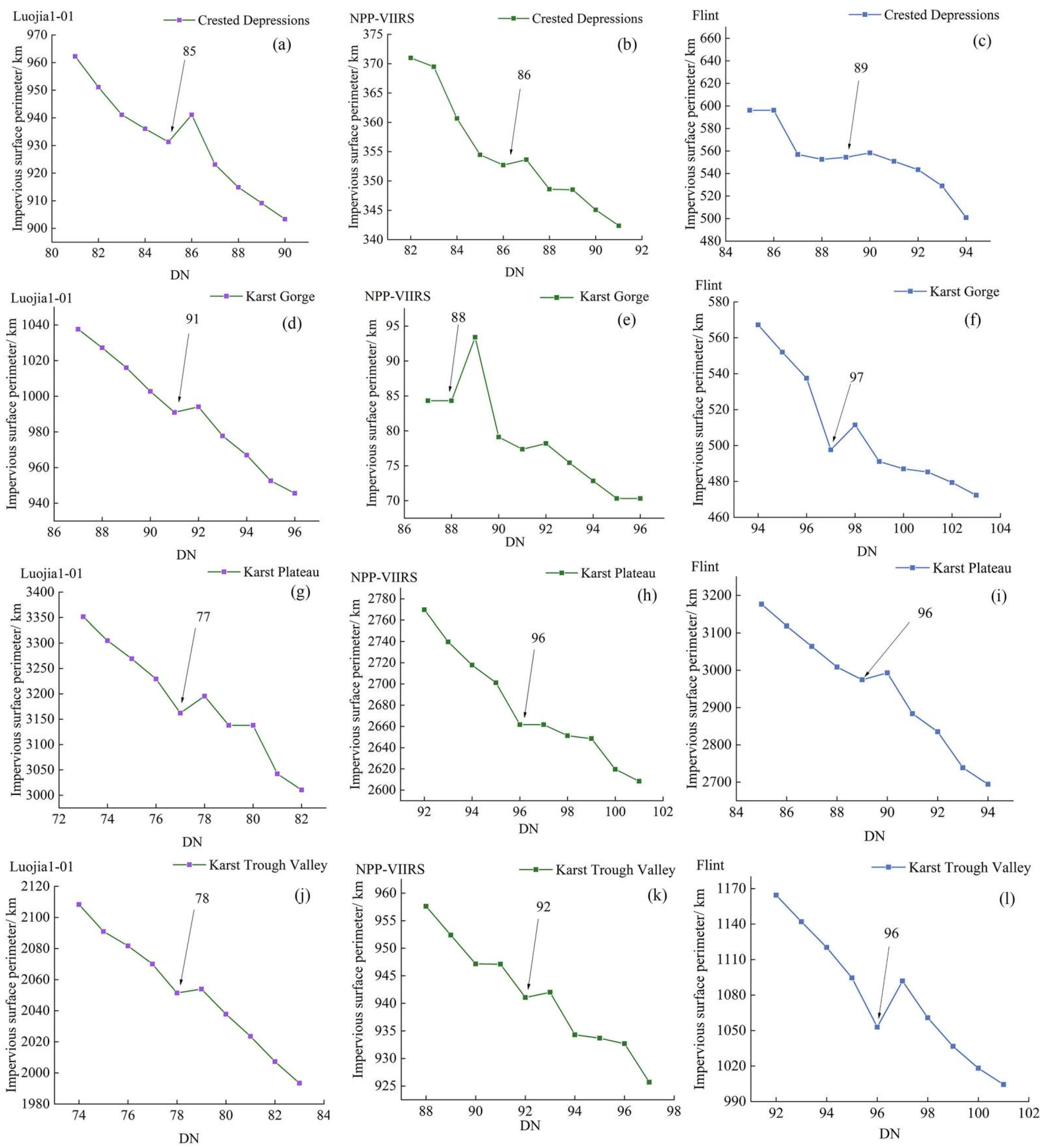
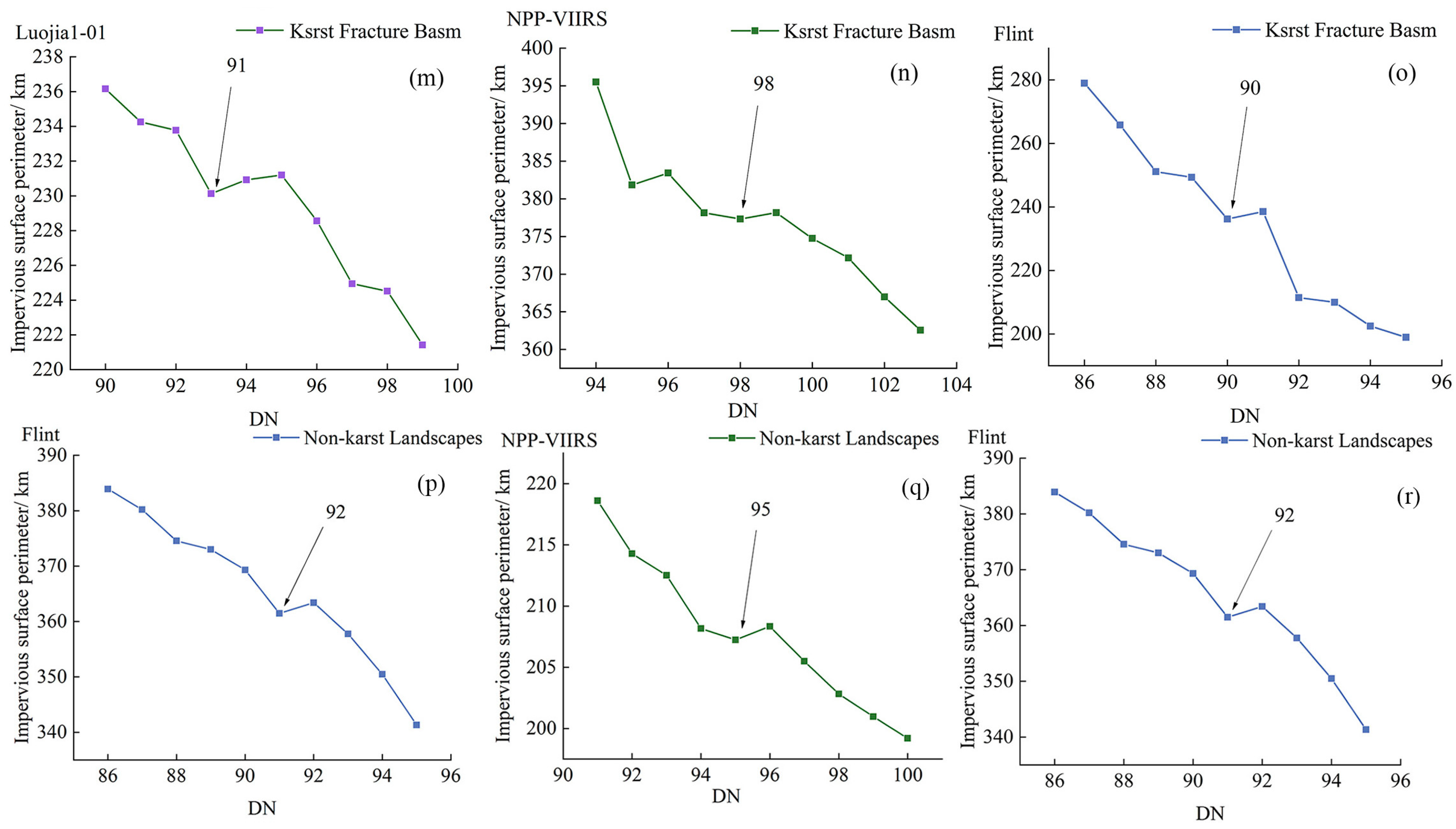

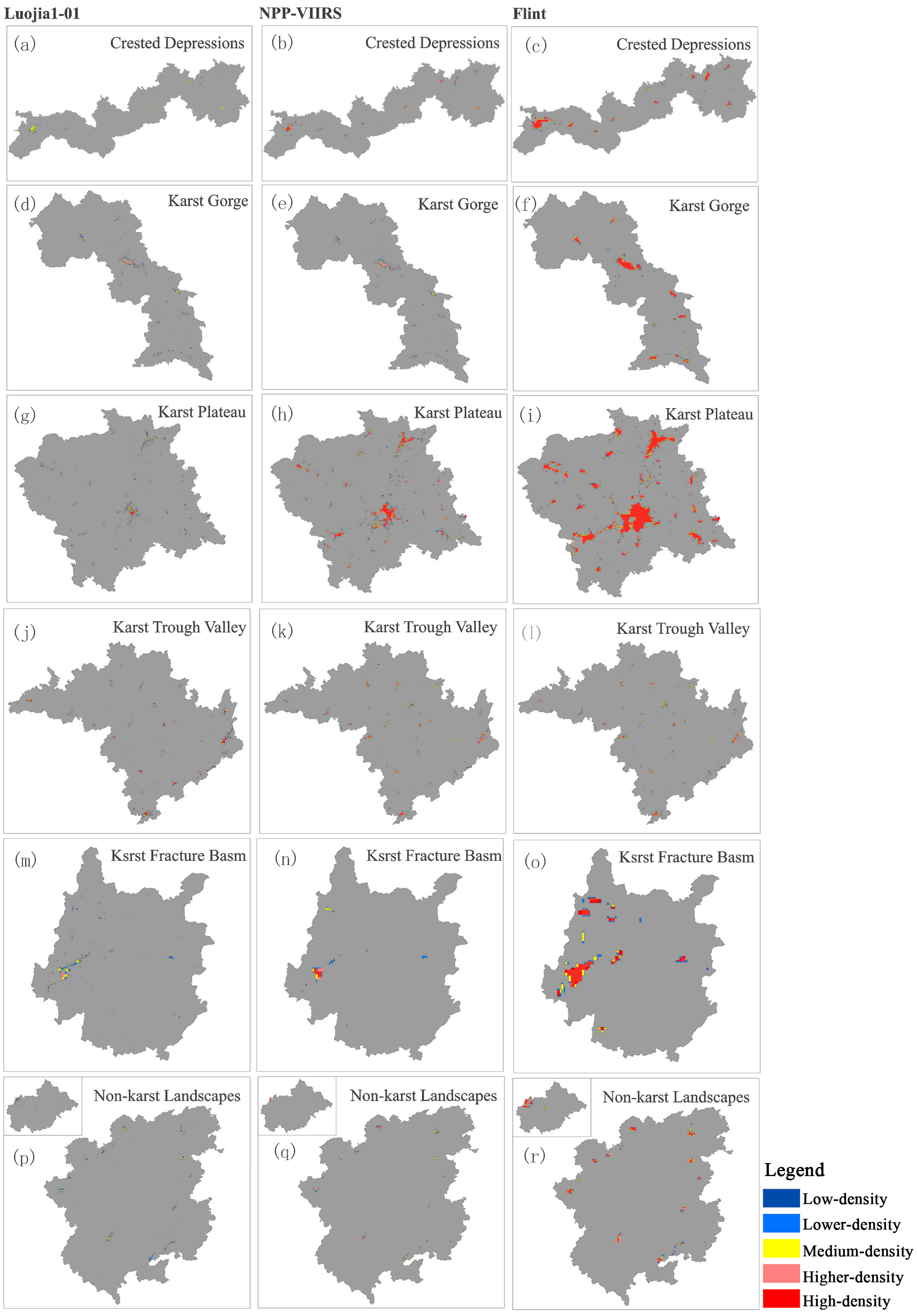
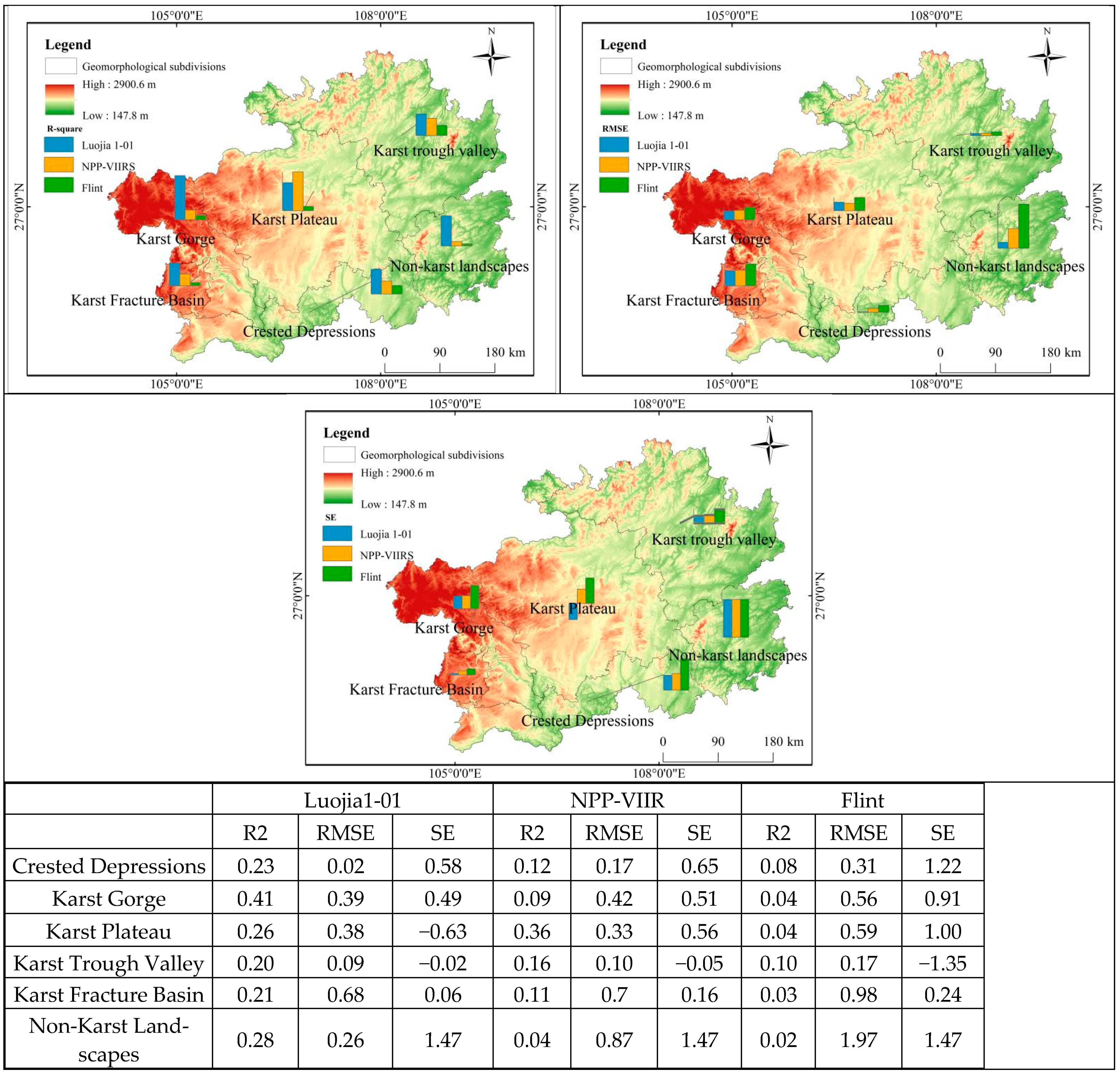

Disclaimer/Publisher’s Note: The statements, opinions and data contained in all publications are solely those of the individual author(s) and contributor(s) and not of MDPI and/or the editor(s). MDPI and/or the editor(s) disclaim responsibility for any injury to people or property resulting from any ideas, methods, instructions or products referred to in the content. |
© 2023 by the authors. Licensee MDPI, Basel, Switzerland. This article is an open access article distributed under the terms and conditions of the Creative Commons Attribution (CC BY) license (https://creativecommons.org/licenses/by/4.0/).
Share and Cite
Zhang, J.; Zhou, Z.; Huang, D. Extraction of Impermeable Surfaces Based on Multi-Source Nighttime Light Images of Different Geomorphological Partitions. Appl. Sci. 2023, 13, 3006. https://doi.org/10.3390/app13053006
Zhang J, Zhou Z, Huang D. Extraction of Impermeable Surfaces Based on Multi-Source Nighttime Light Images of Different Geomorphological Partitions. Applied Sciences. 2023; 13(5):3006. https://doi.org/10.3390/app13053006
Chicago/Turabian StyleZhang, Jiashuo, Zhongfa Zhou, and Denghong Huang. 2023. "Extraction of Impermeable Surfaces Based on Multi-Source Nighttime Light Images of Different Geomorphological Partitions" Applied Sciences 13, no. 5: 3006. https://doi.org/10.3390/app13053006
APA StyleZhang, J., Zhou, Z., & Huang, D. (2023). Extraction of Impermeable Surfaces Based on Multi-Source Nighttime Light Images of Different Geomorphological Partitions. Applied Sciences, 13(5), 3006. https://doi.org/10.3390/app13053006





